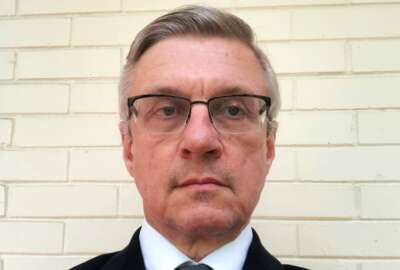
NIH scientists credited with breakthrough in treating a genetic disorder
A major breakthrough in treating sickle cell can be credited to research from one of the scientists at the National Institutes of Health.
Best listening experience is on Chrome, Firefox or Safari. Subscribe to Federal Drive’s daily audio interviews on Apple Podcasts or PodcastOne.
A major breakthrough in treating a genetic disorder can be credited to our next guest. Sickle cell disease is a blood disorder that affects more than 20 million people worldwide. They’ve recently had a breakthrough. Federal News Network’s Eric White spoke to one of the scientists at the National Institutes of Health conducting research on sickle cell on Federal Drive with Tom Temin. Dr. John Tisdale is a finalist in this year’s Service to America Medals program.
Interview transcript:
Dr. John Tisdale: I trained in internal medicine, and that was in the early 90s. I encountered patients with sickle cell disease who were experiencing extraordinary pain. And at that time, all we had was pain medication. So we would give pain medication and IV fluids because very often dehydration was what provoked the pain episode in these patients. But we had no specific treatments, nothing that were directed at the disease itself, only management of the pain. It was strange to me because I had learned about sickle cell disease in genetics classes and had known that we knew the basis for this disease longer than any other disease, yet we had no treatment, nothing. So it motivated me to think about ways that could treat the disease. The obvious thing that came to mind was a bone marrow transplant because we had a very active bone marrow transplant service at Vanderbilt. And I found that a very exciting way to approach disease and it just made sense that if you have a blood disease that causes all this difficulty in blood comes from the bone marrow — well one obvious way to fix it is just to replace the bone marrow with one that doesn’t have the genetics that causes the disease, like a brother or sister that we were doing for other kinds of diseases, and that could potentially cure the disease. And in fact, I learned that it had been done before in a patient who had leukemia. And that was a reason for her getting a bone marrow transplant. But she also had sickle cell disease and she was cured of both. There were some efforts during that time to bring that to the clinic, in the pediatric setting, and everything is always easier with kids because they’re tougher when it comes to medications and transplants and all the things that you can think of doing, chemotherapy. That got me motivated into studying hematology and bone marrow transplant, and trying to figure out ways to bring bone marrow transplant to patients with sickle cell disease.
Eric White: This sickle cell disease, obviously we’ve all heard of it. Even if you know what it is, it’s still a complicated disease. Can you explain what is the latest research says that sickle cell disease actually does over? As I said it’s a very strange disease that affects the body in many different ways. Are there any new findings as to how it does actually affect it?
Dr. John Tisdale: Well, I think we’ve known for a very long time exactly what happens in this disease. It arose as a way to protect from death from malaria. So just one little letter off for the gene that makes our hemoglobin, and hemoglobin is the molecule in red blood cells that carries oxygen around the blood. So one letter off in part of that molecule, and you have protection from malaria, you don’t get the very severe form of malaria because the red cell is not as hospitable to the parasite. So that gets selected for in areas where there’s malaria, like in Sub Saharan Africa. But if you get two copies of the gene, one from mom and one from dad, you get this disease, sickle cell disease because the hemoglobin now is different than the normal hemoglobin. Instead of carrying oxygen around and staying in solution like it does normally, you have a hemoglobin that once it does its job by dropping off oxygen out in the body, it can come out of solution and become like rock hard, distort the shape of the red cell that’s normally squeezing through blood vessels to find its way back to the lungs to get more oxygen. When that happens, block the circulation. So it kind of causes a log jam and all the blood behind it gets stuck. And so wherever that happens, gets starved of its oxygen. So I mean, if it happens in the brain, for example, it causes a stroke. And so kids, eight years old can have a stroke that looks exactly like the sort that we see in the elderly who have vascular disease. If it happens in the muscle, it’s extremely painful or in the bone. And it happens in every organ in the body. And as a result can damage those organs over time and significantly shorten the lifespan of patients with sickle cell disease. So the lifespan currently is in the 40s. And that’s much improved over the last several decades, but it’s still much lower than then people without the disease.
Eric White: So with your research, what has given you the most promise? What results have you all hung on to whether it’s bone marrow transplant or gene therapy? Is there one that you say hey, we might be on to something here?
Dr. John Tisdale: Well, I think the biggest breakthrough that we’ve made is figuring out just how much of the bone marrow we have to fix. So it turns out, we don’t have to completely replace the bone marrow with somebody else’s bone marrow to make the blood normal. So normally in a bone marrow transplant you you have to give chemotherapy to take away all of the cells that are making blood. That’s kind of like tilling the garden, right? You can’t go out in the middle of a cornfield and spread a bunch of tomato seeds and expect to have tomatoes there, they’re not going to grow because the corns already growing. So the thinking is to do a bone marrow transplant, you have to harvest the corn, till the soil, plant the sees. And the same is true for bone marrow transplants. But it turns out for sickle cell disease, we don’t have to do that. We’ve had patients who even though we try to get rid of all their bone marrow, we failed and they had up to 80% of their own bone marrow still making blood, and presumably sickle blood. But if we had only 20% from the donor that was making normal blood, that would result in all of the blood being normal. And that’s just because sickle cells live 10 or 12 days in the circulation, normal cells live 120 days in the circulation. And since the normal cells have such an advantage, you don’t really have to completely eradicate the patient’s own bone marrow or you don’t have to fix every cell. So that’s important. That told us two things. One, we don’t have to use toxic chemotherapy that we normally have to use to do a bone marrow transplant. And furthermore, we can start to think about gene therapy as an approach because we know we can never fix every cell. But if we could fix 20% of cells, we would predict from what we’ve observed in patients getting transplants from their brother or sister, that we’d be able to fix the disease. And we’re well above the 20% mark when we transfer genes into cells. We can also correct the mutation at higher than 20%. So knowing that we only have to get to 20% has allowed us to start clinical trials, using the patient’s own bone marrow where we take those seeds out and try to fix them and give them back. If we can make 20%, we think we can fix the disease.
Eric White: Is there anything else that you’d like to get the word out on? Is there any way people might be able to help or if if they have any family members who are suffering from this, if there’s anything you would like to tell them?
Dr. John Tisdale: Well, I mean, I think the thing that’s very important to understand for anyone with a genetic disease or otherwise is that clinical trials are the way that we make progress. And so participating in clinical trials is important for moving the field forward, and we partner with our patients and their family and their support structure to do these clinical trials and to make progress in the disease. So it’s extraordinarily important for people to understand that. That’s the way we make progress. You know we’ve gone from 10-20% cure rates in children with acute leukemia to now more than 95% cure rates in children with acute leukemia. And that’s because the vast majority of kids with this leukemia were enrolled on clinical trials, where they tested this — the other combination of chemotherapy, all of them already existing until they found the recipe that was the best for curing these leukemias. And so clinical trials are extraordinarily important in helping us move forward to finding cures. And we have to continue this effort because what we’re doing now is difficult. A bone marrow transplant is not a walk in the park. Both the bone marrow transplants that I talked about initially and the gene therapy approaches are in fact bone marrow transplants. And we need to figure out ways to do this more safely, more efficiently, and at less cost. So we’re now very much engaged in trying to figure out ways to do this without having to actually take bone marrow stem cells out, rather to give something that would find its way through the bone marrow in the patient.
Copyright © 2025 Federal News Network. All rights reserved. This website is not intended for users located within the European Economic Area.
Tom Temin is host of the Federal Drive and has been providing insight on federal technology and management issues for more than 30 years.
Follow @tteminWFED





